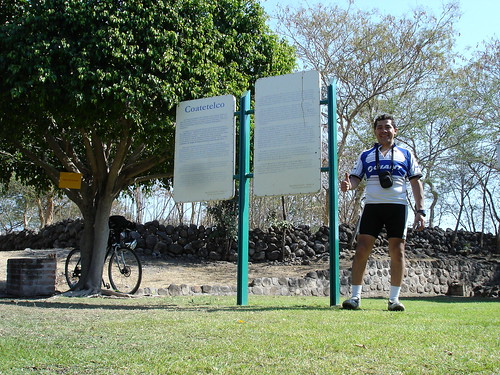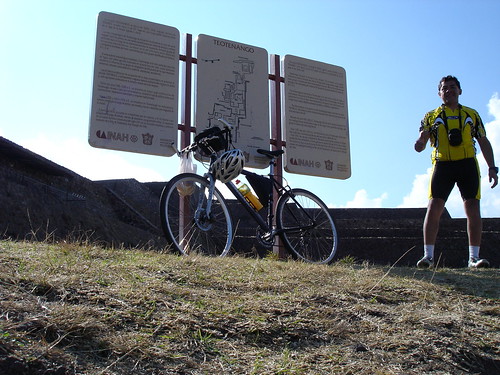Tepoztlan Archaeological Site (Morelos), 25.02.07
Map Navigation: This dynamic Trackmap shows the GPS track (red line) and some geo-referenced photos (red dots) of the cycling tour. Wheel up and wheel down your mouse to zoom in or zoom out the map. Click on any point in the map to center it on that point. Or just drag the map with your mouse. To see the photos, hoover the mouse over the red dots. Click on the photo to go to the picture page.

Photoset Map
Photoset Show
GPS Track: GPX (MapSource, et al), or KMZ (Google Earth)

Photoset Map
Photoset Show
GPS Track: GPX (MapSource, et al), or KMZ (Google Earth)
GPS Cycling Data:



Distance: 170 Km. Climb: 2615 m. Time: 7:15 hr, Average Speed: 23.45 Km/hr, Energy expended: 31.38 MJ, Cycling Power: 300 W



Distance: 170 Km. Climb: 2615 m. Time: 7:15 hr, Average Speed: 23.45 Km/hr, Energy expended: 31.38 MJ, Cycling Power: 300 W
Travel Report:
Starting at 09:20, this ride was a long one. Certainly starting at a late hour, I decided not to stop before reaching Tepoztlán (the destination). So, I took Tlalpan and later the free highway to Cuernavaca. On Tres Marías I changed paths and took the paid highway to Cuernavaca. After La Pera curve there is the deviation to Tepoztlán (where I arrived at 12:12).
I headed immediately to the Archaeological Site, a hill known as the Tepozteco Hill. Rode the bike up to where it was possible (where the stone stairs start) and left the bike in the last food shop (delicious fruits and juices), where I could leave (attended) the bike. I started the ascent to the Tepozteco Hill, 400 m over the Tepoztlán valley, finishing it in 30 min. After taking some shots of this small archaeological site (and having a look at the incredible vista of the valley from the Tepozteco Hill), the descent was carried up (caveat: the track to the hill, the archaeological site of the Tepozteco Hill, and the whole town of Tepoztlán are packed with tourists !)
I went to the center of the town, and enter at Our's Lady Mary Convent of Tepoztlán (official name), to pay it a rewarding visit. This Convent is really impressive for its just restaurated frescos and arches. There is also a beautiful archaeological museum in its interior.
It was now time to get back to Mexico City. At 15:40 I started the ascent from the center of the town. Unfortunately I took the wrong way and was descending again to Cuernavaca ! After a kilometer or so, I turned back to Tepoztlán and was now in the right direction at the gas station at 16:20. At 16:57 I finished that infamous ascent to the paid highway to Mexico. I reached Tres Marías at 18:36, no without some minor physical nuisances as I was now mildly de-hydrated :-( Under the cover of the night I reached La Cima summit and started the descent to Mexico City (800 m below). I arrived safe at Tlalpan and took it to get back home at 21:00 :-)
Photos ? In the links above. Thank you for reading.
Starting at 09:20, this ride was a long one. Certainly starting at a late hour, I decided not to stop before reaching Tepoztlán (the destination). So, I took Tlalpan and later the free highway to Cuernavaca. On Tres Marías I changed paths and took the paid highway to Cuernavaca. After La Pera curve there is the deviation to Tepoztlán (where I arrived at 12:12).
I headed immediately to the Archaeological Site, a hill known as the Tepozteco Hill. Rode the bike up to where it was possible (where the stone stairs start) and left the bike in the last food shop (delicious fruits and juices), where I could leave (attended) the bike. I started the ascent to the Tepozteco Hill, 400 m over the Tepoztlán valley, finishing it in 30 min. After taking some shots of this small archaeological site (and having a look at the incredible vista of the valley from the Tepozteco Hill), the descent was carried up (caveat: the track to the hill, the archaeological site of the Tepozteco Hill, and the whole town of Tepoztlán are packed with tourists !)
I went to the center of the town, and enter at Our's Lady Mary Convent of Tepoztlán (official name), to pay it a rewarding visit. This Convent is really impressive for its just restaurated frescos and arches. There is also a beautiful archaeological museum in its interior.
It was now time to get back to Mexico City. At 15:40 I started the ascent from the center of the town. Unfortunately I took the wrong way and was descending again to Cuernavaca ! After a kilometer or so, I turned back to Tepoztlán and was now in the right direction at the gas station at 16:20. At 16:57 I finished that infamous ascent to the paid highway to Mexico. I reached Tres Marías at 18:36, no without some minor physical nuisances as I was now mildly de-hydrated :-( Under the cover of the night I reached La Cima summit and started the descent to Mexico City (800 m below). I arrived safe at Tlalpan and took it to get back home at 21:00 :-)
Photos ? In the links above. Thank you for reading.












